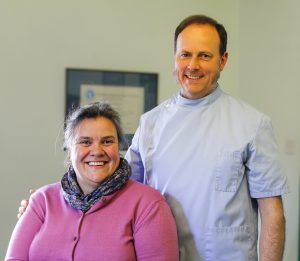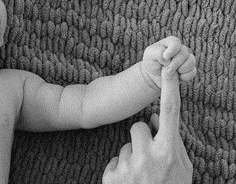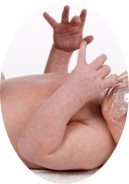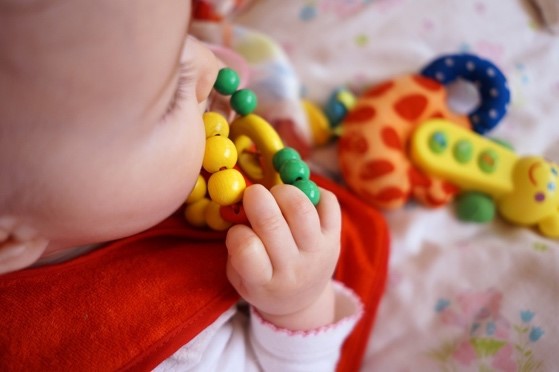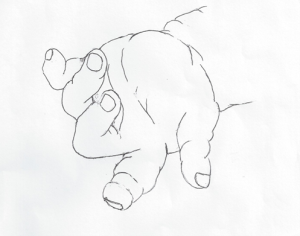 We all know that we use our hands all the time, but have you ever thought how a baby starts to acknowledge and use their hands. Your babies’ hands are part of a beautiful, choreographed ballet, between muscles, brain, vestibular (balance) and visual development that happens in the first year of life. This sets the scene for onward use of the hand, limbs, and body for the rest of their lives. Wherever possible you should leave your baby free of mitts so they can explore for hand development. This is sometimes difficult when they have eczema and scratch a lot. In this case when you are watching your baby and providing stimulation have their hands free. They are less likely to be scratching if you are engaging them or they are motivated by a toy or rattle.
Your baby is born with a primitive reflex known as the grasp reflex this allows you to slip your finger inside their palm and for them to grab your finger. At first, they grasp more with their 4th and 5th fingers and then as they develop it becomes more with their first finger and thumb. According to an observational study on children, the palmar reflex is stronger if the baby is hungry and could indicate the baby’s need to be breastfed. The reflex disappears by 5- 6 months of age as they need to develop other skills such as crawling.
We all know that we use our hands all the time, but have you ever thought how a baby starts to acknowledge and use their hands. Your babies’ hands are part of a beautiful, choreographed ballet, between muscles, brain, vestibular (balance) and visual development that happens in the first year of life. This sets the scene for onward use of the hand, limbs, and body for the rest of their lives. Wherever possible you should leave your baby free of mitts so they can explore for hand development. This is sometimes difficult when they have eczema and scratch a lot. In this case when you are watching your baby and providing stimulation have their hands free. They are less likely to be scratching if you are engaging them or they are motivated by a toy or rattle.
Your baby is born with a primitive reflex known as the grasp reflex this allows you to slip your finger inside their palm and for them to grab your finger. At first, they grasp more with their 4th and 5th fingers and then as they develop it becomes more with their first finger and thumb. According to an observational study on children, the palmar reflex is stronger if the baby is hungry and could indicate the baby’s need to be breastfed. The reflex disappears by 5- 6 months of age as they need to develop other skills such as crawling. A baby brings their hands to the middle of their body and into their mouth by around 8 weeks. After this it slowly and persistently develops using the wrist to help position the hand and developing the use of pincer grip with index finger and thumb. Babies are motivated by wishing to grab a toy or object and this leads them to practise these small movements over and over again perfecting the movement and, in the process, they lay down important nerve pathways. Ultimately the hand develops to become a precision tool being able to manipulate buttons, write use tools such a woodwork tools or sewing needles etc.
The baby also gains information about its spatial orientation we call this proprioception. It starts in the womb when they touch the side of the uterus their tactile receptors are activated, and they learn about their body parts starting a map of where their body parts are in space. So having their hands free is an important part of developing this mapping system. The mapping system informs your child about the relative position of their body parts and how to use them.

